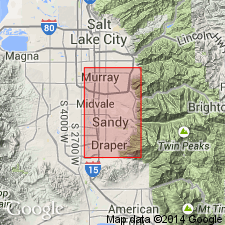
- Usage in publication:
-
- Draper Formation*
- Modifications:
-
- Named
- Dominant lithology:
-
- Sand
- Gravel
- Siltstone
- AAPG geologic province:
-
- Wasatch uplift
Summary:
Named as the upper formation of the Lake Bonneville Group for the town of Draper, Salt Lake Co, UT. Type area is a strip extending 0.25 mile each side of Dry Creek from its mouth to the center of sec 15, T3S, R1E, Salt Lake Co, UT on the Wasatch uplift. Includes three tongues which consist mainly of siltstone, sand, and gravel. The oldest, or lower, tongue has a maximum altitude of 4,770 ft. The middle tongue has a maximum altitude of 4,470 ft. The upper, or youngest, tongue has a maximum altitude of 4,410 ft. Lower tongue is about 38 ft thick; upper tongue is 2 ft thick. Thickness of middle tongue not stated. The tongues are locally separated by disconformities and rarely by subaerial deposits such as alluvium and colluvium. Intercalated soils not found. Tongues also have a silt-clay facies, but this facies was not mapped. Formation records a major lake rise and two smaller oscillations. Geologic map. Correlation chart. Is younger than Graniteville Soil and older than Midvale Soil. Of late Pleistocene age.
Source: GNU records (USGS DDS-6; Denver GNULEX).
For more information, please contact Nancy Stamm, Geologic Names Committee Secretary.
Asterisk (*) indicates published by U.S. Geological Survey authors.
"No current usage" (†) implies that a name has been abandoned or has fallen into disuse. Former usage and, if known, replacement name given in parentheses ( ).
Slash (/) indicates name conflicts with nomenclatural guidelines (CSN, 1933; ACSN, 1961, 1970; NACSN, 1983, 2005, 2021). May be explained within brackets ([ ]).

